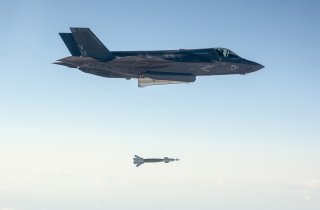Firing Lasers from Fighter Jets? That’s the U.S. Military’s Goal.
Lasers and many laser technologies such as rangefinders and spotters are already used in many applications, including deployed Navy ships. At the same time, the Pentagon and military services are moving quickly to develop newer, stronger, more-mobile laser weapons.
Firing lasers from fighter jets while in combat, hitting enemy hypersonic missiles in space and incinerating enemy drones from armored combat vehicles are all missions intended for fast-emerging, now-in-development laser weapons.
Lasers and many laser technologies such as rangefinders and spotters are already used in many applications, including deployed Navy ships. At the same time, the Pentagon and military services are moving quickly to develop newer, stronger, more-mobile laser weapons. Much of this includes “laser scaling” and “size, weight and power” improvements intended to engineer lasers able to arm fighter jets and even destroy enemy ICBMs in space.
In order for scientists and weapons developers to engineer lasers strong and durable enough to travel into space and build compact, transportable, smaller-form-factor lasers able to integrate into fast-moving, fighter jets and transportable soldier devices. The Missile Defense Agency is now “power scaling” lasers in preparation for using them for missile defenses, the Air Force Research Laboratory is miniaturizing strong mobile power systems to fire lasers from fighter jets and the Army is already arming Stryker vehicles with laser weapons.
Now, Army developers and New York University scientists may have achieved a technical breakthrough enabling weapons developers to engineer stronger, longer-range and more durable laser weapons.
The breakthrough pertains to complex scientific advancement with optics and photons at the molecular and most elemental levels. Researchers are now able to engineer what’s called a 3D photonic crystal lattice structure better able to contain and streamline the application of laser light.
“If you take specific lasing technologies and put them inside of a photonic crystal there is no way for unwanted light to escape from the phonetic crystal so the laser does not emit unwanted wavelengths to escape,” Dr. Evan Runnerstrom, Program Manager, Army Research Office, Combat Capabilities Development Command, Army Futures Command, told the National Interest in an interview.
The concept, already showing promise in the laboratory, is to use small particles to construct a symmetrical structure able to effectively manage light energy and prevent small amounts of light energy from “leaking out from the main beam.”
“For the first time, we can use self-assembly of small particles to make a 3D diamond lattice, which is a precursor to creating a 3D photonic crystal. 3D photonic crystals can be tuned to control light in specific ways. Photonic crystals design materials that interact with light. If we design these properly we can control light with very fine precision and localize it in ways we want,” Runnerstrom said.
The researchers published their findings in an academic essay called “Colloidal Diamond,” in Nature Journal. The scientific progress is identified as an ability to assemble small photonic “colloidal” particles into a diamond-like structure able to effectively contain, and strengthen beams of light.
“Colloidal diamonds are beneficial because they suppress spontaneous emission of light and are valued for their applications as optical waveguides, filters and laser resonators, for improving light-harvesting technologies,” the essay abstract states.
What this means is that, should this progress be further developed, weapons developers may have discovered new ways of strengthening laser beams for military use, signaling a promising technological “breakthrough.”
Kris Osborn is the defense editor for the National Interest. Osborn previously served at the Pentagon as a Highly Qualified Expert with the Office of the Assistant Secretary of the Army—Acquisition, Logistics & Technology. Osborn has also worked as an anchor and on-air military specialist at national TV networks. He has appeared as a guest military expert on Fox News, MSNBC, The Military Channel, and The History Channel. He also has a Masters Degree in Comparative Literature from Columbia University. This first appeared earlier and is being reposted due to reader interest.
Image: Reuters

